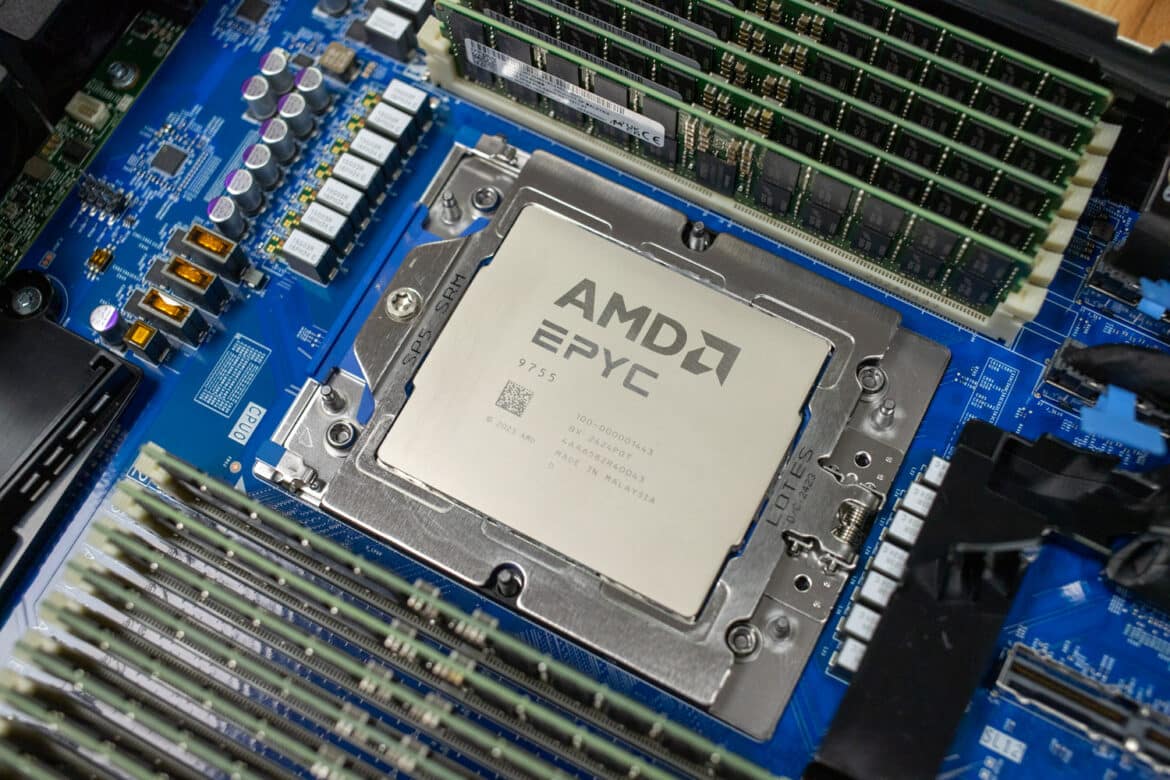With the AMD EPYC Turin 9005 series launch, powered by the latest Zen 5 architecture, AMD again raises the bar for enterprise computing.
AMD’s EPYC line has long been a staple in the data center industry, offering unmatched performance, scalability, and power efficiency. With the EPYC Turin 9005 series launch, powered by the latest Zen 5 architecture, AMD once again raises the bar for enterprise computing. This new generation is more than just a step forward—it’s a giant leap in processing power and efficiency, tailor-made for the ever-growing demands of modern data centers.
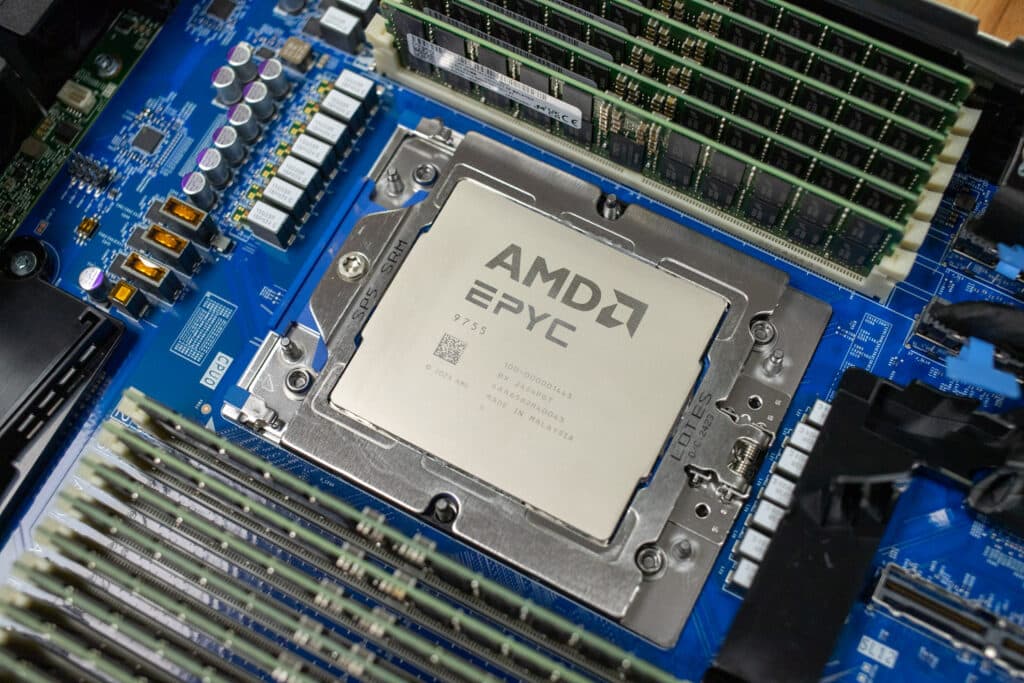
AMD Zen 5 Architecture
This section summarizes much of the information from our earlier coverage; you can learn more from our announcement coverage.
At the heart of the EPYC Turin series is AMD’s Zen 5 architecture, unveiled at the 2024 Tech Day. Designed from the ground up to tackle the challenges of the data-driven world, Zen 5 introduces several critical enhancements that aim to optimize workloads across high-performance computing, AI, cloud, and edge environments. The EPYC 9005 series CPUs offer significantly increased core counts and improved threading capabilities, making them a prime choice for enterprises seeking to consolidate infrastructure while boosting performance.
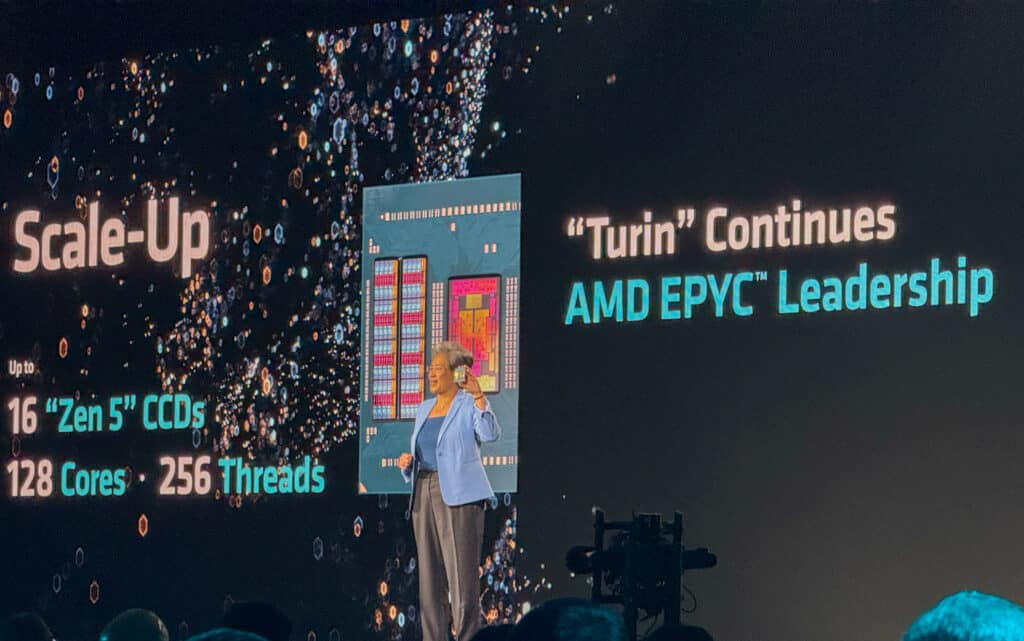
AMD also strongly emphasizes power efficiency, a critical factor in today’s environmentally conscious data center landscape. The Zen 5 chips feature architectural enhancements that improve thermal and electrical performance, achieved through AMD’s ongoing collaboration with TSMC and their cutting-edge manufacturing processes. This allows data centers to maximize performance per watt, helping operators reduce operational costs and meet sustainability goals without sacrificing throughput.
The Zen 5 EPYC line advertises advanced AI capabilities as a headline feature. The refresh of the Math Acceleration Unit provides a boost in performance for machine learning and cryptographic tasks, offering up to 35% improvement in single-core AES-XTS encryption and a 32% boost in single-core machine learning tasks over Zen 4. This positions the EPYC Turin series as a pivotal solution for enterprises focusing on AI-driven workloads, where speed and efficiency are critical.
The architecture’s improved data bandwidth also plays a crucial role in performance gains. Featuring a redesigned 48KB L1 data cache with double the bandwidth to both the cache and the Floating-Point Unit, the EPYC 9005 series ensures that data-heavy applications—such as large-scale simulations and real-time analytics—run smoother and faster than ever before. Additionally, the AVX-512 implementation with a full 512-bit data path ensures that floating-point and vector math operations, essential for AI and HPC workloads, are handled with significantly enhanced efficiency.
For data center operators, the EPYC Turin 9005 series doesn’t just represent an upgrade in performance—it delivers a transformative shift in how data centers can operate at scale. From its exceptional core density to its advanced AI capabilities and power efficiency, the EPYC 9005 series is built to tackle the most demanding workloads of today and tomorrow.
AMD EPYC Turin Features
AMD’s Turin is all about performance and adaptability. With configurations of up to 128 cores for scale-up setups and an impressive 192 cores for scale-out environments, these processors are built to handle demanding tasks like AI training, simulations, and large databases across various platforms.
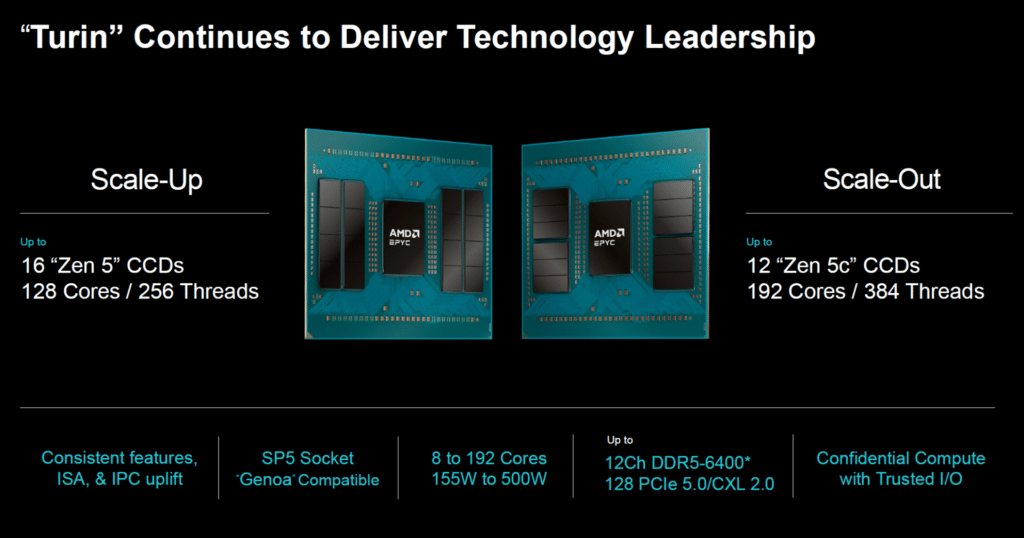
With core counts from 8 to 192 and TDPs from 155W to 500W, Turin CPUs provide versatile power options. Moreover, advanced features like 12-channel DDR5 memory support up to 6400 MT/s and up to 128 lanes of PCIe 5.0 and CXL 2.0 ensure fast, efficient data handling, ideal for bandwidth-heavy applications. The processors’ compatibility with existing SP5 sockets simplifies upgrades, while comprehensive security features—Confidential Compute and Trusted I/O—address the increasing need for secure processing. Integrating 12-channel DDR5 support with speeds up to 6400 MT/s is particularly useful for bandwidth-heavy workloads.
AMD EPYC processors also thrive in AI-intensive environments thanks to a strategic partnership with NVIDIA. Tailored configurations like those in NVIDIA’s HGX and MGX platforms demonstrate how AMD’s EPYC CPUs work well in setups that require powerful GPU support. High-frequency options like the EPYC 9575F, which reaches up to 5 GHz, are specifically designed for applications that demand low latency and rapid processing times. This positions AMD well in real-time AI processing and allows users to tailor systems from single-threaded tasks to large-scale parallel workloads while carefully balancing power and efficiency.
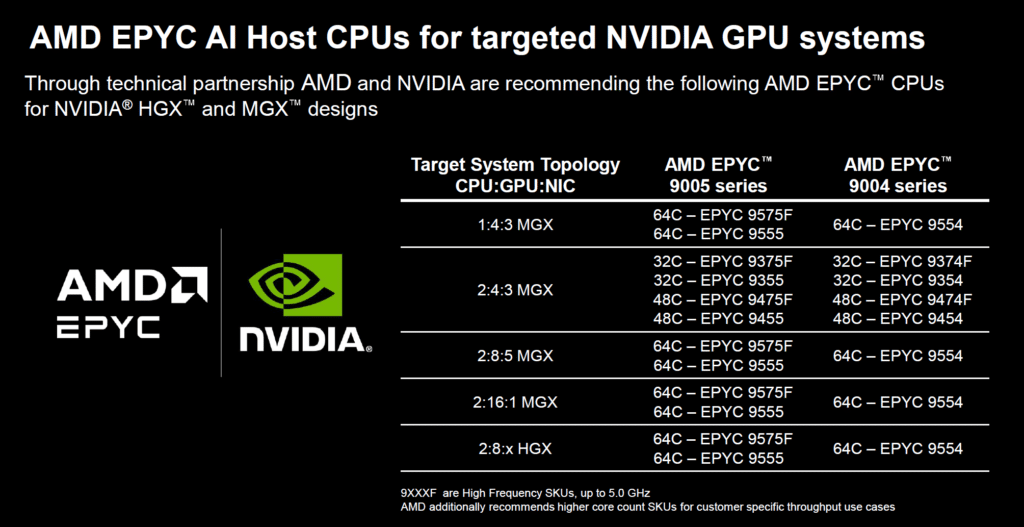
AMD claims its 5th Gen EPYC processors outshine Intel’s offerings in AI-specific benchmarks, particularly in machine learning and large language model tasks. According to AMD’s tests, these CPUs boast up to a 3.8x advantage, making them especially suitable for real-time AI applications where responsiveness and low latency are crucial. AMD’s focus on optimizing AI inference enables faster decision-making in data-intensive applications like recommendation systems and similarity searches.
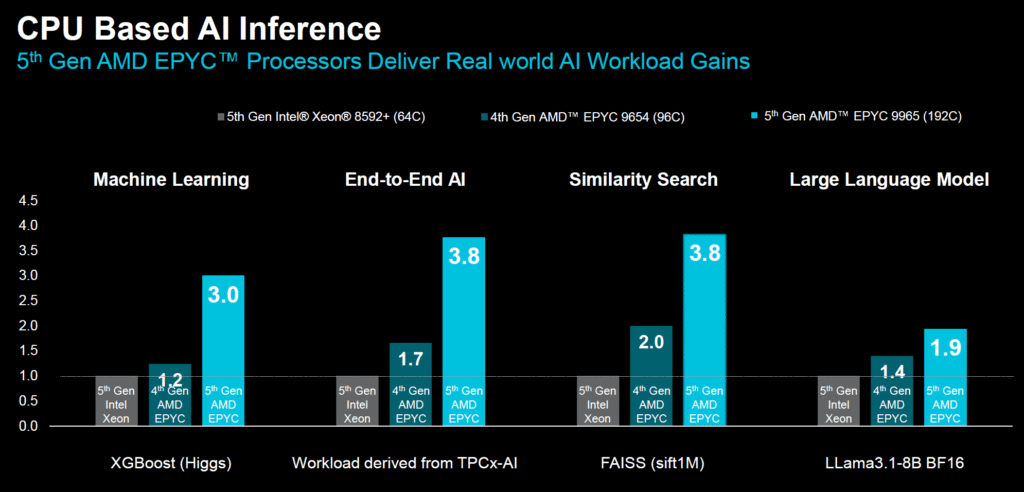
AMD EPYC Turin CPU SKU Sheet
The AMD EPYC Turin CPU lineup offers remarkable diversity tailored to meet numerous enterprise demands. From high-core powerhouses designed for data-intensive environments to lower-core, high-frequency options ideal for specialized tasks, this series delivers scalable performance and efficiency options suited to any workload.
| Cores | Model/CCD | Base/Boost | TDP | L3 Cache (MB) | Price (1 KU, USD) |
|---|---|---|---|---|---|
| 192 cores | 9965 “Zen5c” | 2.25 / 3.7 | 500W | 384 | $14,813 |
| 160 cores | 9845 “Zen5c” | 2.1 / 3.7 | 390W | 320 | $13,564 |
| 144 cores | 9825 “Zen5c” | 2.2 / 3.7 | 390W | 384 | $13,006 |
| 128 cores | 9755 “Zen5” | 2.7 / 4.1 | 500W | 512 | $12,984 |
| 9745 “Zen5c” | 2.4 / 3.7 | 400W | 256 | $12,141 | |
| 96 cores | 9655 “Zen5” | 2.6 / 4.5 | 400W | 384 | $11,852 |
| 9655P “Zen5” | 2.6 / 4.5 | 400W | 384 | $10,811 | |
| 9645 “Zen5c” | 2.3 / 3.7 | 320W | 256 | $11,048 | |
| 72 cores | 9565 “Zen5” | 3.15 / 4.3 | 400W | 384 | $10,486 |
| 64 cores | 9575F “Zen5” | 3.3 / 5.0 | 400W | 256 | $11,791 |
| 9555 “Zen5” | 3.2 / 4.4 | 360W | 256 | $9,826 | |
| 9555P “Zen5” | 3.2 / 4.4 | 360W | 256 | $7,983 | |
| 9535 “Zen5” | 2.4 / 4.3 | 300W | 256 | $8,992 | |
| 48 cores | 9475F “Zen5” | 3.65 / 4.8 | 400W | 256 | $7,592 |
| 9455 “Zen5” | 3.15 / 4.4 | 300W | 192 | $5,412 | |
| 9455P “Zen5” | 3.15 / 4.4 | 300W | 192 | $4,819 | |
| 36 cores | 9365 “Zen5” | 3.4 / 4.3 | 300W | 192 | $4,341 |
| 32 cores | 9375F “Zen5” | 3.8 / 4.8 | 320W | 256 | $5,306 |
| 9355 “Zen5” | 3.55 / 4.4 | 280W | 256 | $3,694 | |
| 9355P “Zen5” | 3.55 / 4.4 | 280W | 256 | $2,998 | |
| 9335 “Zen5” | 3.0 / 4.4 | 210W | 128 | $3,178 | |
| 24 cores | 9275F “Zen5” | 4.1 / 4.8 | 320W | 256 | $3,439 |
| 9255 “Zen5” | 3.25 / 4.3 | 200W | 128 | $2,495 | |
| 16 cores | 9175F “Zen5” | 4.2 / 5.0 | 320W | 512 | $4,256 |
| 9135 “Zen5” | 3.65 / 4.3 | 200W | 64 | $1,214 | |
| 9115 “Zen5” | 2.6 / 4.1 | 125W | 64 | $726 | |
| 8 cores | 9015 “Zen5” | 3.6 / 4.1 | 125W | 64 | $527 |
At the top of AMD’s lineup sits the EPYC 9965, the powerhouse of the Turin family, boasting an impressive 192 cores and 384 threads. It operates at a base frequency of 2.25 GHz and boosts up to 3.7 GHz, all while drawing a hefty 500W TDP. With 384 MB of L3 cache, this CPU is built for large-scale data centers or enterprise environments where massive parallel processing is crucial. Priced at $14,813, this model targets organizations that demand high throughput and scalable power for compute-intensive tasks.
Another high-core example is the EPYC 9845, which provides 160 cores and 320 threads, running at a base of 2.1 GHz and a boost of 3.7 GHz. At 390W TDP and 320 MB of L3 cache, this model is optimized for heavy multi-threaded workloads but with slightly lower power consumption than the 9965.
Moving down the stack, the EPYC 9755 is a versatile 128-core processor with 256 threads, a base clock of 2.7 GHz, and a boost up to 4.1 GHz, designed for balanced performance and energy efficiency at a 500W TDP. With 512 MB of L3 cache, it’s ideal for a mix of general-purpose and data-intensive applications, making it a prime choice for virtualization, cloud environments, and complex data analytics.
The EPYC 9655 (96 cores, 192 threads) is another standout in this category. It runs at a 2.6 GHz base with a 4.5 GHz boost and operates within a 400W power envelope. It features 384 MB of L3 cache, making it suitable for environments prioritizing a high core count and frequent memory access, such as large-scale virtualization and containerized applications.
In the lower core count range, models like the EPYC 9575F and EPYC 9555 deliver high single-thread performance, with a clock speed of up to 5.0 GHz on the 9575F. The 9575F, equipped with 64 cores and 128 threads, runs at a 3.3 GHz base.
Another attractive model is the EPYC 9475F, which features 48 cores and 96 threads, a base clock of 3.65 GHz, and a boost up to 4.8 GHz. This CPU costs $7,592, so it strikes a nice balance between frequency and core count.
AMD offers options like the EPYC 9375F with 32 cores and 64 threads for less intensive workloads or entry-level deployments. This model is priced at $5,306 and runs at a base frequency of 3.8 GHz and boosts to 4.8 GHz within a 320W TDP. With 256 MB of L3 cache, this CPU provides more than capable performance in scenarios where high frequency and moderate core counts can make a difference in day-to-day operational efficiency.
Lastly, the EPYC 9175F features a moderate 16 cores and 32 threads with a high boost frequency of 5.0 GHz, making it perfect for entry-level enterprise environments. With its 320W TDP and $4,256 price point, this model is appealing for organizations with more straightforward, less demanding workloads.
AMD EPYC Turin CPU Review Platforms
For this launch, AMD provided us with their Volcano reference platform and a few sets of CPUs for testing. The reference system, which appears to be based on a Lenovo platform, came with 1.5TB of DDR5 running at 6000MT/s and was cooled using an AIO liquid loop. However, while this system was well-suited for general testing, it featured only 3 xGMI links between the CPU and memory controllers.
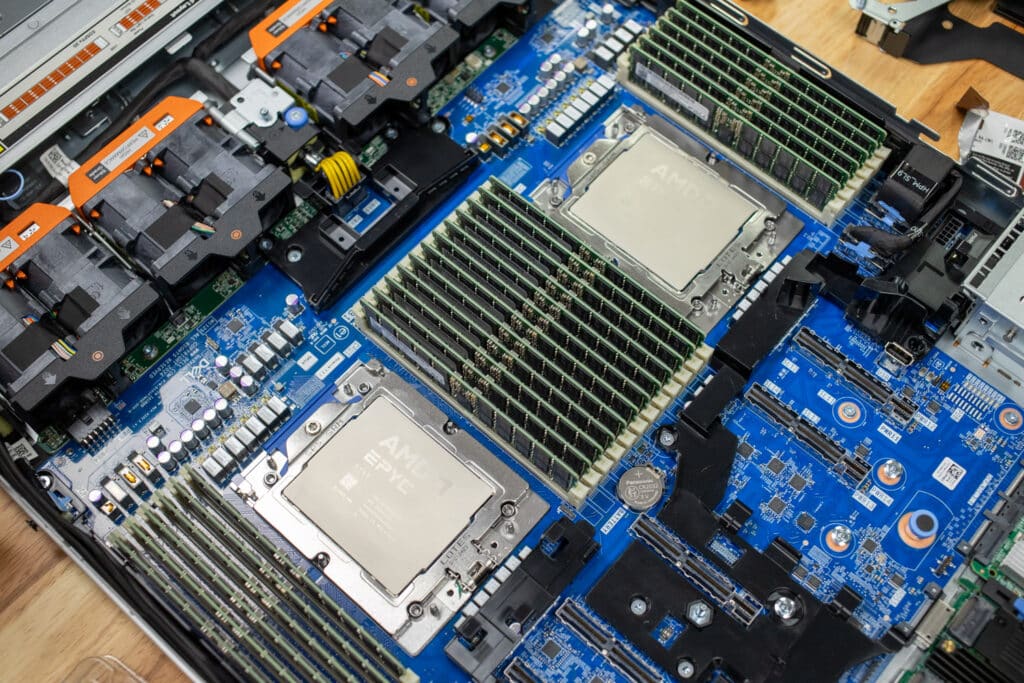
Dell PowerEdge R6725
To extend our testing, we used pre-production versions of Dell’s new PowerEdge R7725 and R6725 platforms—Dell’s latest 2U and 1U AMD-based servers, respectively. These platforms were particularly valuable for our review because they support 4 xGMI links, providing superior bandwidth and efficiency for high-intensity workloads compared to the reference design.
Both Dell platforms were outfitted with 1.5TB of DDR5 at 6000MT/s, cooled by platinum-grade fans capable of handling the 500W CPUs on air. During lab testing, the air cooling on these systems performed exceptionally well, keeping the processors within safe operating temperatures. However, to accommodate ongoing cooling renovations in our lab, we used a CoolIT SP5 cold plate kit connected to a CDU to ensure stable temperatures and lower noise levels during extended workloads. This setup allowed us to push the Dell servers to their limits. At the same time, the liquid loop solution primarily addressed our unique environmental constraints rather than any performance limitations of the platforms themselves. All tests were performed with Noctua NT-H2 Thermal paste and the CollIT SP5 direct-to-chip liquid cooling solution.
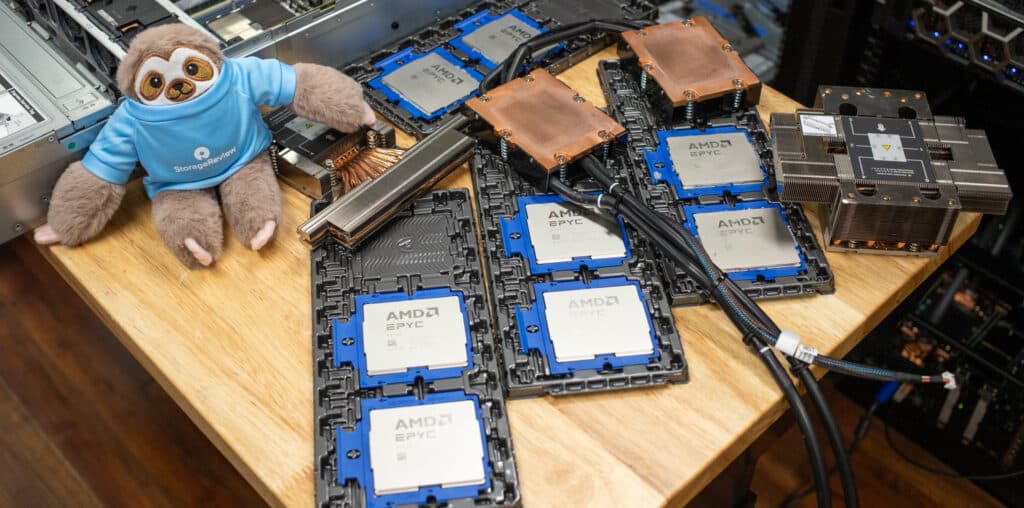
AMD EPYC Turin Performance
We will now examine the headline performance of AMD’s latest EPYC Turin CPUs, comparing their capabilities across a series of high-demand benchmarks to the Genoa and Bergamo models. These tests cover a range of scenarios—from AI inference and 3D rendering to computational workloads and data compression—aimed at evaluating multi-thread efficiency, core scalability, and single-threaded power.
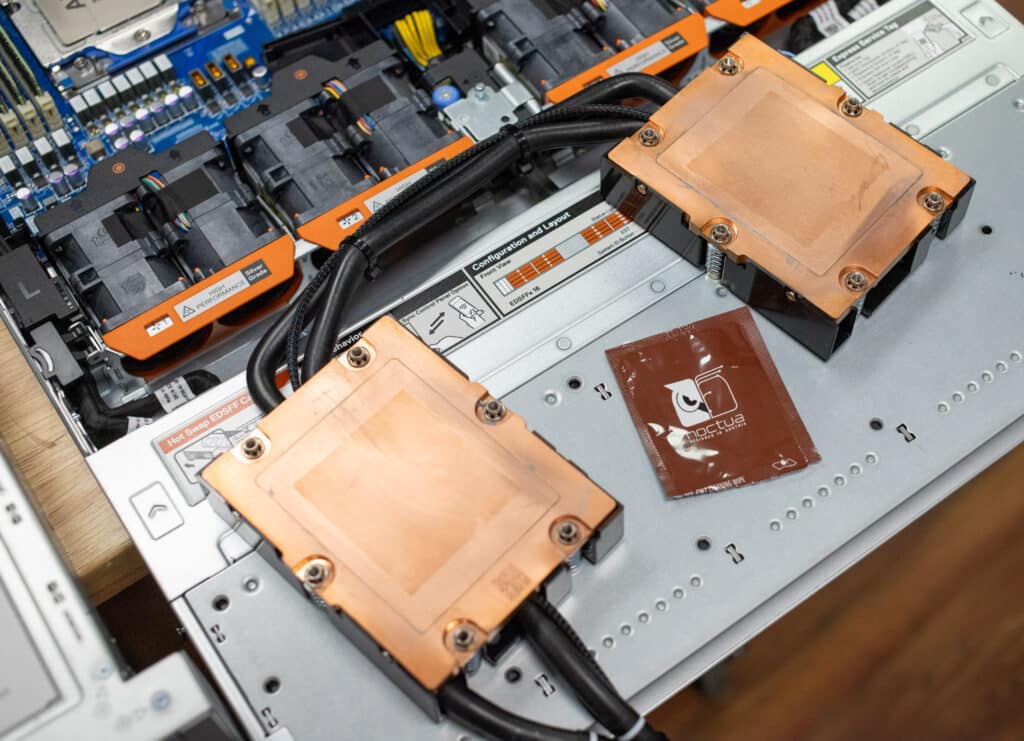
CoolIT Cold Plates
With configurations ranging from the massive 192-core EPYC 9965 to the streamlined 64-core EPYC 9575F, we performed all tests with SMT disabled, the top performance profiles in iDRAC, and power determinism to let the CPUs perform at their maximum. This will allow us to provide insight into how each model balances core count, frequency, and efficiency to address diverse workloads.
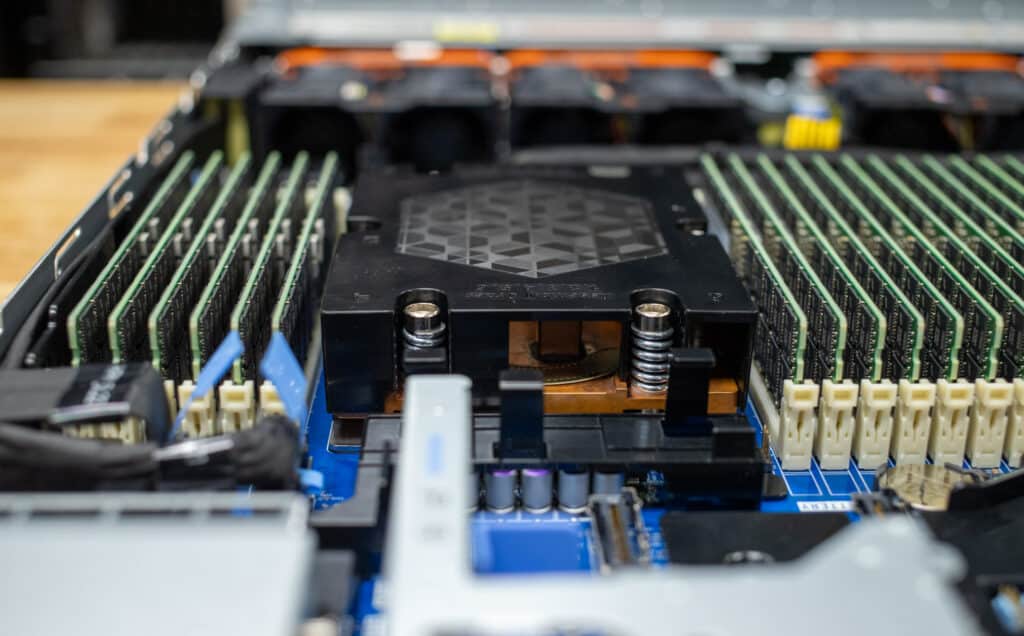
Geekbench 6
The Geekbench 6 cross-platform benchmark measures a system’s performance and provides a comparison score. It is designed to work on multiple platforms and provides a consistent performance measurement across many devices, from smartphones and tablets to desktops and servers.
Here, the EPYC 9965’s 192 cores deliver a multi-core score of 11,199, providing considerable processing power but still falling behind dual-socket Genoa (20,217) and Bergamo (17,916) configurations. This suggests that while the 9965 is a solid performer, Genoa and Bergamo remain optimized for the most extreme parallel processing workloads. The EPYC 9755’s 128 cores demonstrate efficiency gains, slightly outperforming the 9965 in both single-core (1,641) and multi-core (11,800) scores, which indicates that it is finely tuned for scalable, multi-threaded tasks without the overhead of larger core counts.
Meanwhile, the 9575F (with SMT disabled) scores a solid 1,865 in single-core, showing potential for applications that benefit from high single-threaded performance. In contrast, its 64-core multi-core score of 13,219, although modest, makes it more suitable for specialized workloads rather than the heaviest parallel processing tasks.
| Geekbench 6 | AMD EPYC 9965 (192c) | AMD EPYC 9755 (128c) | AMD EPYC 9575F (64c) | Genoa (2p/96c) | Bergamo (2p/128c) |
| Single Core | 1,453 | 1,641 | 1,865 | 2,048 | 1,723 |
| Multi-Core | 11,199 | 11,800 | 13,219 | 20,217 | 17,916 |
Maxon Cinebench
Cinebench is a widely used benchmarking tool that measures the performance of CPUs and GPUs using Maxon Cinema 4D for rendering. It provides a score that can compare the performance of different systems and components. We ran four popular versions of Cinebench so you can compare the results on popular leaderboards online.
The Cinebench R23 results show the EPYC 9755 with a high multi-core score of 131,846, outperforming Genoa’s 116,744 and Bergamo’s 102,125, positioning it as an ideal choice for rendering-intensive tasks in highly parallel environments. Genoa leads with 1,294 points in single-core performance, giving it a slight edge in applications that favor faster single-thread operations.
In the updated Cinebench 2024 tests, the 9965 and 9755 continue to perform well with 4,845 and 5,921 points, respectively, delivering solid multi-threaded scores suited for tasks like complex 3D rendering and content creation workflows.
| Test | AMD EPYC 9965 (192c) | AMD EPYC 9755 (128c) | AMD EPYC 9575F (64c) |
Genoa (2p/96c) | Bergamo (2p/128c) | |
| Cinebench R20 | ||||||
| CPU | N/A | 43,765 pts | N/A | N/A | N/A | |
| Cinebench R23 | ||||||
| CPU (Multi Core) | N/A | 131,846 pts | 111,149 pts | 116,744 pts | 102,125 pts | |
| CPU (Single Core) | N/A | 1,400 pts | 1,052 pts | 1,294 pts | 1,089 pts | |
| Cinebench 2024 | ||||||
| CPU (Multi Core) | 4,845 pts | 5,921 pts | 4,324 | N/A | N/A | |
| CPU (Single Core) | 77 pts | 84 pts | 103 pts | N/A | N/A | |
y-cruncher
y-cruncher 0.8.3.9522 is a multi-threaded, scalable program that can compute Pi and other mathematical constants to trillions of digits. Since its launch in 2009, it has become a popular benchmarking and stress-testing application for overclockers and hardware enthusiasts.
Here, the EPYC 9575F (SMT off) achieves the quickest computation times for both 1 and 2.5 billion digit calculations, clocking in at 4.476 and 10.067 seconds, respectively. This speed surpasses even the high-core 9965 and 9755 models, demonstrating its efficiency for high-precision tasks that do not require extreme thread counts.
Meanwhile, the 9965 and 9755 also offer strong times, notably outperforming Genoa and Bergamo at 10 billion digits, completing in just over 41 seconds compared to Genoa’s 51 seconds. This shows that the Turin-based EPYCs are well-optimized for computation-heavy applications, demonstrating scalable performance that allows for more refined control over thread and resource management. The 64-core 9575F really shined here with its incredibly high clockspeed, showing a strong advance over the cores in the 9755 or 9965 samples in the y-cruncher ranges we looked at.
| y-cruncher Total Computation Time (Lower is Better) | AMD EPYC 9965 (192c) | AMD EPYC 9755 (128c) | AMD EPYC 9575F (64c, 128t) | AMD EPYC 9575F (64c) | Genoa (2p/96c) | Bergamo (2p/128c) |
| 1 Billion | 7.346 seconds | 7.747 seconds | 5.408 seconds | 4.476 seconds | 8.882 seconds | 9.184 seconds |
| 2.5 Billion | 13.661 seconds | 14.113 seconds | 11.376 seconds | 10.067 seconds | N/A | N/A |
| 5 Billion | 23.211 seconds | 22.820 seconds | 20.177 seconds | 20.030 seconds | N/A | N/A |
| 10 Billion | 41.750 seconds | 41.512 seconds | 40.767 seconds | 41.518 seconds | 51.071 seconds | 55.683 seconds |
| 25 Billion | 115.091 seconds | 98.981 seconds | 103.650 seconds | 104.737 seconds | N/A | N/A |
y-cruncher BBP
This y-cruncher benchmark utilizes the Bailey-Borwein-Plouffe (BBP) formulas to compute massive hexadecimal digits of Pi, measuring the CPU’s total computation time, utilization, and multi-core efficiency. The results provide a detailed performance analysis of the AMD Turin CPUs under these intensive calculations.
The EPYC 9575F with SMT off excels in single-thread efficiency, completing 1 BBP in just 0.179 seconds with a multi-core efficiency of 44.73%. This demonstrates its effectiveness in scenarios where single-threaded optimization is prioritized. By comparison, the 9965, with its 192 cores, shows a lower multi-core efficiency of 4.61% in this single-BBP test, as its high core count introduces latency in low-thread scenarios.
Multi-core efficiency becomes more apparent at higher workloads, like 10 and 100 BBP. The EPYC 9575F with SMT off maintains a strong lead with 86.59% efficiency at 10 BBP, completing it in 0.896 seconds. For 100 BBP, the 9575F continues to excel, reaching nearly 99% efficiency and showing balanced performance in highly parallel workloads, completing the run in 8.065 seconds. In this test, the 9965 achieves 85.10% efficiency, while the 9755 and 9575 maintain competitive multi-core efficiencies of 94% and 96.83%, respectively, demonstrating that Turin-based EPYC CPUs can manage low and high-thread workloads effectively.
| Benchmark | AMD EPYC 9965 (192c) | AMD EPYC 9755 (128c) | AMD EPYC 9575F (64c) |
AMD EPYC 9575F (64c, SMT off) |
| 1 BBP |
|
|
|
|
| 10 BBP |
|
|
|
|
| 100 BBP |
|
|
|
|
7Zip Compression Benchmark
The built-in memory benchmark in the 7-Zip utility measures the performance of a system’s CPU and memory during compression and decompression tasks, indicating how well the system can handle data-intensive operations. We run this test at a 128MB dictionary size when possible.
The 7-Zip compression benchmark demonstrates the 9755’s efficiency, achieving 443.029 GIPS at 5613% CPU utilization, the highest across the EPYC lineup. This performance level makes the 9755 ideal for intensive data compression tasks, such as those in backup or archival solutions, where quick data handling is essential. The 9575F (SMT disabled) also performs well, reaching 394.9 GIPS. These results indicate that the 9755 and 9575F have solid compression and decompression capabilities, with high CPU throughput and effective resource management for applications that leverage high compression ratios or handle large volumes of data.
| 7-Zip Compression Benchmark (Higher is better) | AMD EPYC 9965 (192c) | AMD EPYC 9755 (128c) | AMD EPYC 9575F (64c, SMT off) |
|
| Compressing | ||||
| Current CPU Usage | 4302% | 5233% | 4406% | |
| Current Rating / Usage | 5.830 GIPS | 7.597 GIPS | 7.975 GIPS | |
| Current Rating | 250.827 GIPS | 397.536 GIPS | 351.358 GIPS | |
| Resulting CPU Usage | 4041% | 5306% | 4555% | |
| Resulting Rating / Usage | 5.804 GIPS | 7.720 GIPS | 8.070 GIPS | |
| Resulting Rating | 234.317 GIPS | 409.652 GIPS | 367.358 GIPS | |
| Decompressing | ||||
| Current CPU Usage | 4322% | 6041% | 5017% | |
| Current Rating / Usage | 7.078 GIPS | 8.065 GIPS | 8.483 GIPS | |
| Current Rating | 305.909 GIPS | 487.263 GIPS | 425.580 GIPS | |
| Resulting CPU Usage | 4556% | 5921% | 4940% | |
| Resulting Rating / Usage | 6.577 GIPS | 8.045 GIPS | 8.569 GIPS | |
| Resulting Rating | 299.163 GIPS | 476.405 GIPS | 422.441 GIPS | |
| Total Rating | ||||
| Total CPU Usage | 4298% | 5613% | 4747% | |
| Total Rating / Usage | 6.190 GIPS | 7.883 GIPS | 8.319 GIPS | |
| Total Rating | 266.740 GIPS | 443.029 GIPS | 394.900 GIPS | |
Blender OptiX
Blender OptiX is an open-source 3D modeling application. This benchmark was run using the Blender Benchmark CLI utility. The score is samples per minute, with higher being better.
Here, the 9755 outperforms slightly with a 2,606.54 samples per minute score in the “Monster” scene, with the 9965 closely following at 2,558.43. Both outperform the Genoa and Bergamo, scoring 1,700.65 and 2,038.71, respectively, emphasizing the advantage Turin-based CPUs bring to 3D rendering. These scores showcase the 9755’s and 9965’s suitability for high-resolution 3D modeling tasks and content creation workflows involving complex scene rendering.
| Blender 4.0 CPU Samples Per Minute (Higher is Better) | AMD EPYC 9965 (192c) | AMD EPYC 9755 (128c) | AMD EPYC 9575F (64c) |
Genoa (2p/96c) | Bergamo (2p/128c) |
| Monster | 2,558.43 | 2,606.54 | 1,196.15 | 1,700.65 | 2,038.71 |
| Junkshop | 1,866.65 | 1,843.48 | 802.00 | 1,101.84 | 1,382.58 |
| Classroom | 1,270.17 | 1,251.54 | 637.13 | 869.48 | 1,045.96 |
UL Procyon
UL’s Procyon AI Inference benchmark suite tests how various AI inference engines perform using state-of-the-art neural networks. We ran these tests only on the CPU. Each number is an average inference time, where lower is better, with the last row providing an overall score where higher is better.
Here, the EPYC 9575F with SMT off delivers solid inference times across various neural networks, with standout performances in MobileNet V3 (7.02 ms) and ResNet 50 (10.45 ms). These scores surpass both Genoa (3.63 ms for MobileNet and 6.34 ms for ResNet) and Bergamo (4.16 ms and 8.22 ms, respectively) for AI workloads, suggesting that the 9575F’s SMT-off configuration prioritizes latency control, making it highly efficient for real-time AI tasks where low inference times are critical.
The EPYC 9965 and 9755, while not as fast in single-inference tasks as Genoa, maintain strong performance across the board, with the 9755’s 20.07 ms on MobileNet and 20.11 ms on ResNet 50 indicating steady, reliable performance suited for moderate workloads.
While Genoa and Bergamo offer consistently lower latency, the 9575F, particularly with SMT off, delivers great latency control.
| UL Procyon Average | AMD EPYC 9965 (192c) | AMD EPYC 9755 (128c) | AMD EPYC 9575F (64c) |
Genoa (2p/96c) | Bergamo (2p/128c) | |
| Inference Times (Lower is Better) | ||||||
| MobileNet V3 | 32.86 ms | 20.07 ms | 7.02 ms | 3.63 ms | 4.16 ms | |
| ResNet 50 | 38.63 ms | 20.11 ms | 10.45 ms | 6.34 ms | 8.22 ms | |
| Inception V4 | 116.38 ms | 66.22 ms | 33.69 ms | 25.99 ms | 30.68 ms | |
| DeepLab V3 | 58.16 ms | 33.02 ms | 19.38 ms | 25.33 ms | 30.57 ms | |
| YOLO V3 | 84.20 ms | 38.47 ms | 24.54 ms | 34.13 ms | 41.38 ms | |
| REAL-ESRGAN | 2923.75 ms | 1600.73 ms | 1219.26 ms | 2524.03 ms | 2301.35 ms | |
| Overall Score (Higher is better) |
44 | 81 | 148 | N/A | N/A | |
Blackmagic RAW
The Blackmagic RAW Speed Test performance benchmarking tool measures a system’s capabilities in handling video playback and editing using the Blackmagic RAW codec. It evaluates how well a system can decode and play back high-resolution video files, providing frame rates for both CPU- and GPU-based processing.
In this test, the EPYC 9755 leads with an impressive 174 fps in 8K CPU decoding, ideal for high-resolution video playback in media production environments. The 9575F (SMT off) closely follows at 154 fps, slightly outpacing the 9965 at 134 fps. These results suggest that the 9755 and 9575F offer the best balance of frame rate consistency and decoding speed, crucial for video editing and production workflows that handle large, high-quality video files.
| Blackmagic RAW (Higher is Better) | AMD EPYC 9965 (192c) | AMD EPYC 9755 (128c) | AMD EPYC 9575F (64c) |
| 8K CPU | 134 fps | 174 fps | 154 fps |
Closing Thoughts
The AMD EPYC Turin 9005 series marks a significant leap forward in enterprise computing, delivering exceptional performance, efficiency, and adaptability across various workloads. Powered by the Zen 5 architecture, these processors are purpose-built to address the growing demands of AI, cloud, and HPC environments while offering unmatched scalability for data centers looking to optimize performance and power consumption.
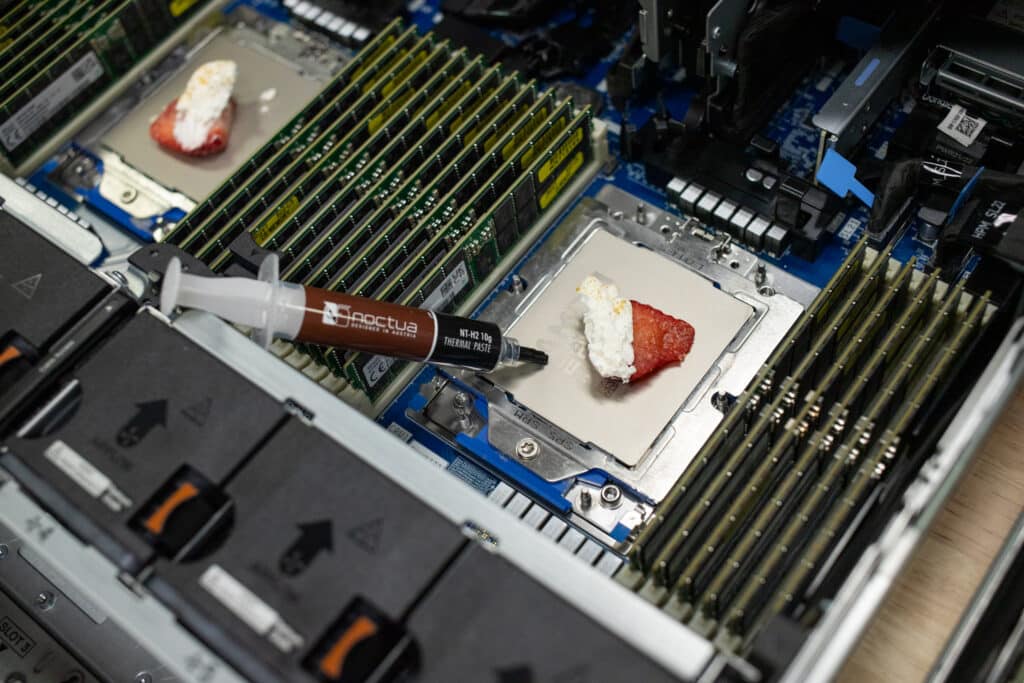
What sets the EPYC 9005 series apart is its ability to meet the diverse needs of modern enterprises with configurations that scale from entry-level, high-frequency models to super cache-dense chips to multi-core powerhouses. Whether real-time AI inferencing, computational fluid dynamics, large-scale data analytics, or high-resolution 3D rendering, the EPYC lineup delivers single-threaded responsiveness and multi-threaded efficiency. Advanced features like 12-channel DDR5 memory support, PCIe 5.0 lanes, and AMD’s secure, confidential computing make this series a performance upgrade and a comprehensive solution for data centers focused on the future.
Our testing with Dell’s PowerEdge R7725 and R6725 platforms showcased the true potential of these processors, particularly with their board design and cooling solution, which provide a distinct advantage in bandwidth and overall performance. The combination of AMD’s exceptional Zen 5 architecture and Dell’s robust server design creates a compelling platform for enterprises looking to push the boundaries of computing power.
Engage with StorageReview
Newsletter | YouTube | Podcast iTunes/Spotify | Instagram | Twitter | TikTok | RSS Feed

